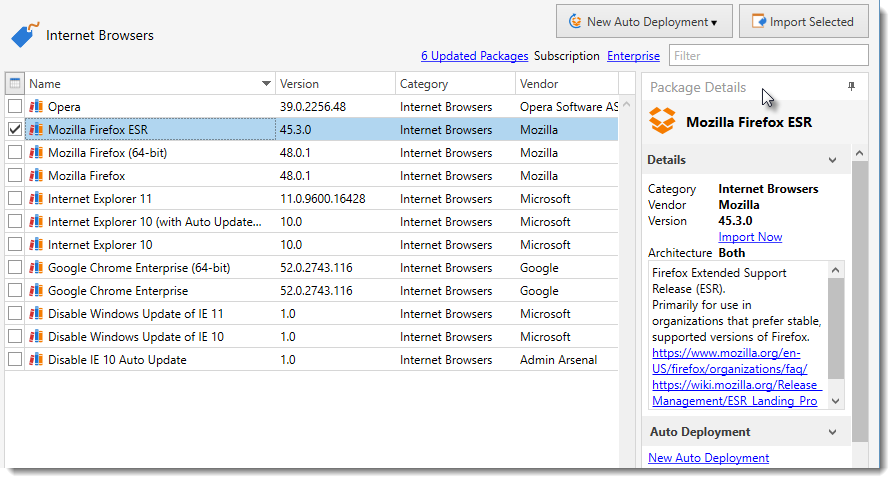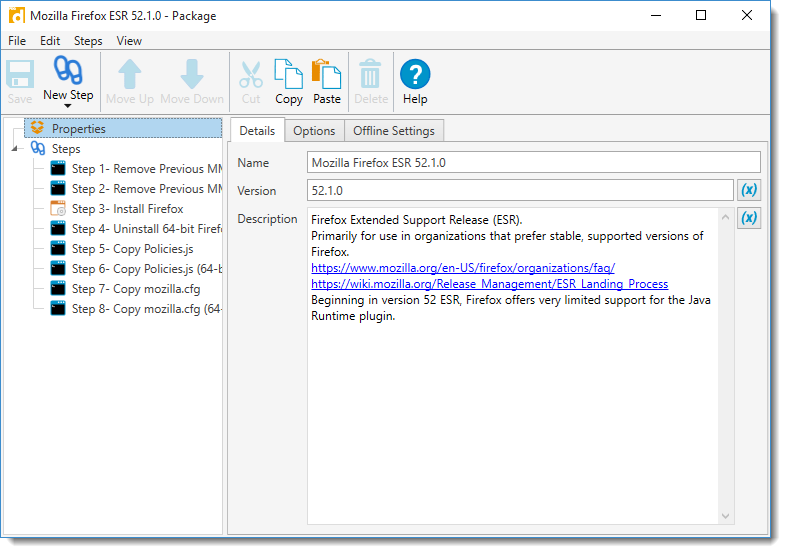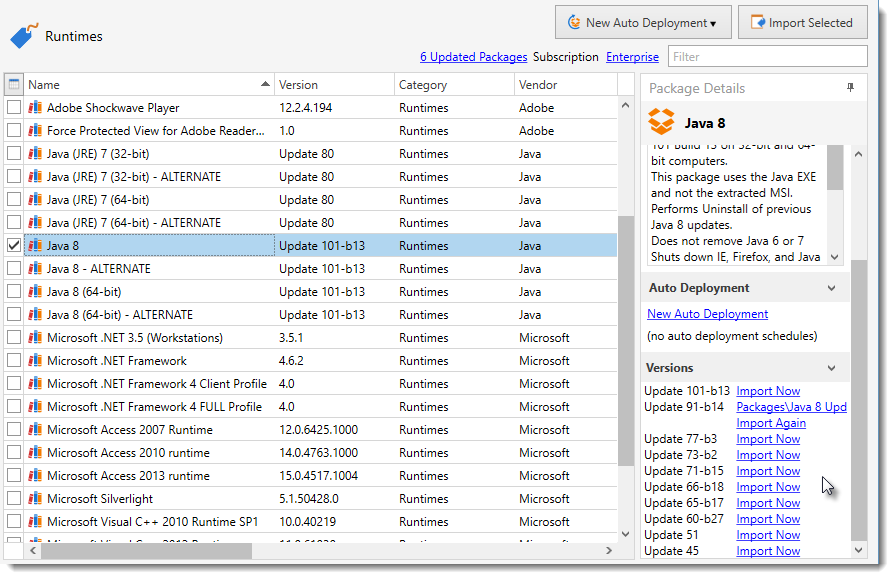A PDQ Deploy Package includes a set of configuration options and instructions plus the install files needed by PDQ Deploy to silently install or update a free application.
When you import a prebuilt package from the Package Library, the configuration information of the package is stored in your local PDQ Deploy database. The install files are downloaded to the Repository, which is stored in the PDQ Deploy %ProgramData% directory by default (for example, C:\Users\Public\Documents\Admin Arsenal\PDQ Deploy\Repository). This directory can be moved and the install files from any packages you import in the future will download to the new location of the repository.
This topic contains the following sections:
•Additional Information About Importing Packages
•Previous Versions of Packages
Importing Prebuilt Packages
To import prebuilt packages from the PDQ Deploy Package Library:
1.On the Main Console tree, click Package Library.
The Package Library page displays.
2.On the tree, navigate using Categories or Vendors to locate the likely package or packages you need.
You can also type keywords in the Filter field on the Package Library page to narrow your search.
TIP: For more ways to filter the Package Library, see Sorting the Package Library. You can also view and sort the Package Library on the web (https://www.pdq.com/package-library-list).
3.Select a package in the list and information about the package displays in Package Details.

Package Details sidebar includes information about the package and what it does.
NOTE: Enterprise license mode users also have access to older prebuilt packages. For more information, see Previous Versions of Packages.
4.Once you have identified the package or packages you need, click the checkboxes to select them.
5.Click Import Selected (or double-click one package or select multiple packages by holding Shift or Ctrl then double-click).
The Download window opens and displays a list of the selected packages and their download progress.
TIP: You can also initiate the importing of a single package from the web version of the Package Library. Click the package you want to download to view the Package Details page, then click Download into PDQ Deploy to automatically import the package.
The new package is added to the Packages folder in the tree.
6.(Optional) When the packages are imported do one of the following:
•Click Close to dismiss the Download window.
•Click View Package to display the specific package page of the newly imported package.

7.(Optional) You can also view and edit the package and package step properties by selecting the package in the tree and double clicking (clicking Edit Package or Ctrl+O) to open. For information about editing and using prebuilt packages as templates, see Managing Packages.

The package is ready to be immediately deployed or scheduled for deployment. For information about deploying packages see Manually Deploying Packages or Setting up Scheduled Deployments.
NOTE: While you can edit packages that you import, you cannot modify the package used for an Auto Deployment. You can add additional steps before and after the Auto Deployment, but you cannot modify the actual Auto Deployment Package. For information about Auto Deployment, see Creating Auto Deployments. For information about adding additional steps to an Auto Deployment, see Editing an Auto Deployment.
Additional Information About Importing Packages
Importing Duplicate Packages
What happens if I import a package that is already downloaded?
The package will be imported again and appear in Packages with a number appended to the package name. If you modify package files, then re-import the package, the changes are lost because the original files are replaced. Note that you may see duplicate packages if you re-import, but don't delete the earlier packages.
Previous Versions of Packages
I need a specific version of an update. How can I find older versions of PDQ Deploy packages?
Enterprise users can access a curated list of previous packages (old versions) in the Package Library. Typically, the older packages will be for the last release of a major version of the software.
To import older versions of packages from the PDQ Deploy Package Library:
1.On the Main Console tree, click Package Library.
2.On the tree, browse to and select the package for the product you need.
Under Package Details > Versions is a list of the older packages available.

3.To import one of the older packages, click the Import Now link for the version you want.
The Download window opens and shows the progress as the package downloads.
Updated Packages
When new or updated packages are added to the Package Library, several indicators on the Main Console window will alert you. The Package Library icon on the toolbar changes from normal ![]() to updated
to updated ![]() . Also, the Updated Packages link on the Package Library page indicates how many updates there are (and the link appears on the Status bar).
. Also, the Updated Packages link on the Package Library page indicates how many updates there are (and the link appears on the Status bar).
To view the list of updated packages, do one of the following:
•On the Package Library page:
•Click the xx Updated Packages link.
•Click the xx Updates tab.
•On the Status bar, click the xx Updated Packages link.
On the xx Updates tab you can browse the updated packages and remove packages from the list (Skip Selected Updates or Skip All Updates).
NOTE: The Package Library is updated when PDQ Deploy is opened, every 2 hours thereafter, and when manually refreshed (View > Refresh or F5). The list of Updated Packages is based on changes to the library after your initial installation or after using Skip All Updates.
Auto Deployment
Auto Deployment is an Enterprise mode feature that allows you to automatically deploy new versions of applications as they become available in the PDQ Deploy Package Library. For details, see Creating Auto Deployments and Package Library Preferences.
Multiple Packages page
When multiple packages are selected in the tree (Shift+Click or Ctrl+Click), the Multiple Packages page opens on the right. From this page, you can perform the following actions:
•Create new package nesting these packages: A New Package window opens with each packages listed as a separate nested step. For details, see Creating a New Package and Nested Package Step Properties.
•Start a deployment with these packages: A Deploy Once window opens with each package selected to be deployed. For details, see Deploying Multiple Packages with Deploy Once.
•Create new schedules with these packages: A new Schedule window opens for all selected packages. For details, see Creating Scheduled Deployments.
•Attach packages to an existing schedule: The Select Schedules window opens. To attach the packages to an existing schedule, simply select the existing schedule and click OK, or double-click the schedule name.

© 2017 PDQ.com Corporation. All rights reserved.
PDQ.com is a trademark of PDQ.com Corporation. All other product and company names are the property of their respective owners.
Help Version: 13.1.0.0